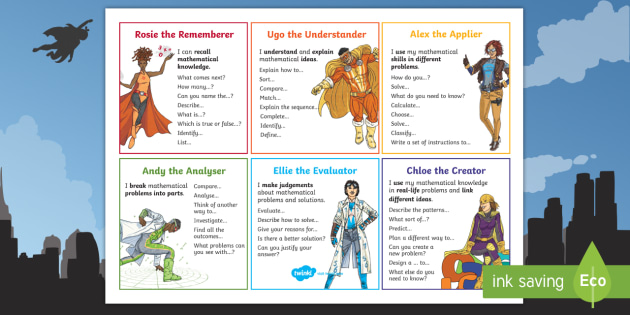
Blooms Taxonomy is often displayed as a pyramid to help illustrate this hierarchy. Find the meaning of.

Remember Understand Apply Analyze Evaluate and Create.
Bloom taxonomy questions for math. His work led to a still widely used educational concept known as Blooms Taxonomy which was revised slightly in 2001. In Blooms Taxonomy there are six levels of skills ranked in order from the most basic to the most complex. Each level of skill is associated with a verb as learning is an action.
As a teacher you should ensure that the questions you ask both in class and on written assignments and tests are pulled from all levels of the taxonomy. Similar to other taxonomies Blooms Taxonomy is a hierarchical learning method. The rationale behind it is that learning at the higher levels is dependent on having attained the prerequisite knowledge and skills at lower levels.
Blooms Taxonomy is often displayed as a pyramid to help illustrate this hierarchy. It is a cake-like structure if imagined emphasizing that each level is built on a. Blooms Taxonomy Sample Questions Remember Useful Verbs Sample Question Stems List Locate Name Recognize State Describe Recall Repeat Retrieve What happened after.
Who was it that. Can you name the. Describe what happened at.
Who spoke to. Can you tell why. Find the meaning of.
Blooms Taxonomy Interpreted for Mathematics Lindsey Shorser This document contains a description of Blooms Taxonomy a educational tool developed by Benjamin S. Bloom 1913-1999 that ranks the relative cogni-tive complexity of various educational objectives. This taxonomy is often used as an aid when create test questions and assignments.
Combine integrate modify rearrange substitute plan create design invent what if compose formulate. Prepare generalise rewrite Adapted from. Ed 1956 Taxonomy of educational objectives.
The classification of educational goals. Handbook I cognitive domain. Aug 18 2012 - Blooms Taxonomy Math Question Stems - Free download as Word Doc doc docx PDF File pdf Text File txt or read online for free.
Sample Question Stems Based on Revised Blooms Taxonomy Remember Understand Apply Who. What does it mean. What is the best one.
Can you name all the. Which is true or false. What does this mean.
Which are the facts. State in your own words. This purchases include 170 Blooms Taxonomy question cardsWhat are Blooms Taxonomy Math CardsBlooms Taxonomy question cards are designed for teachers to use in their math classroom to ensure that they are targeting the different levels of questioning.
Teaching math is a. Lets start at the bottom of Blooms Taxonomy that is. We all know that knowledge aka recalling information is the basic cognitive level of Blooms.
Often my students want me to teach in a way so they can memorize the math steps. They think this means they understand what they are doing. Um no it definitely does not.
Below is a video I show my students every year so they can recognize that. Using Blooms Taxonomy to Plan Questions Resource Back to Table of Contents Level of Thinking Instructional Situations What Students Will Do Question Stems Create When a teacher wants students to synthesize information or material to form a new idea concept or product. Construct design develop formulate generate.
This set of math reflections contains 100 different questions prompts 20 for each level of Blooms Taxonomy There are 6 different levels of questionsprompts that support Blooms Taxonomy Revised. Remember Understand Apply Analyze Evaluate and Create. This set of questionsprompts can b.
Blooms Revised Taxonomy Planning Tool Keywords Questions Creating Create invent compose predict plan construct design imagine propose devise formulate Evaluating Judge select choose decide justify debate verify argue recommend assess discuss rate prioritise determine Analysing Analyse distinguish examine compare contrast. Blooms Taxonomy refers to a classification of the different objectives that educators set for students learning objectives. Blooms Taxonomy divides educational objectives into three domains.
Cognitive Affective and Psychomotor sometimes loosely described as knowinghead feelingheart and doinghands respectively. Within the domains learning at the higher levels is dependent on having attained prerequisite knowledge and skills at lower levels. A goal of Blooms Taxonomy.
Blooms Taxonomy Question Stems Knowledge What happened after. How many. Who was it that.
Can you name the. Described what happened at. Who spoke to.
Can you tell why. Find the meaning of. What is.
Which is true or false. Blooms Taxonomy math question stems are a way of analyzing the levels of mathematics questions within the assessment systems used in Common Core Curriculum. About Press Copyright Contact us Creators Advertise Developers Terms Privacy Policy Safety How YouTube works Test new features Press Copyright Contact us Creators.
Blooms Taxonomy questions are a great way to build and design curriculum and lesson plans. They encourage the development of higher-order thinking and encourage students to engage in metacognition by thinking and reflecting on their own learning. In The Ultimate Guide to Blooms Taxonomy Question Stems you can access more than 100 examples of Blooms taxonomy questions examples and higher-order thinking question examples at all different levels of Blooms Taxonomy.
Blooms Taxonomy Questions As Blooms taxonomy helps organize educational objectives into lower and higher order cognitive thinking levels its underlying framework is extremely useful in assisting teachers in composing questions for students that provide opportunities to.